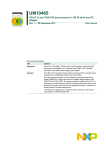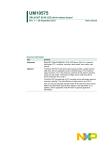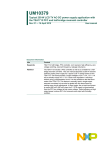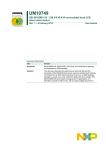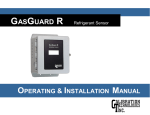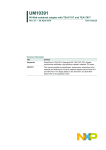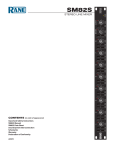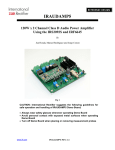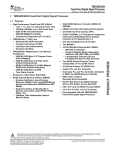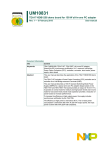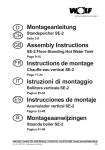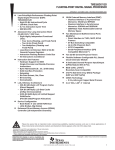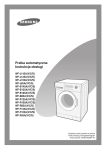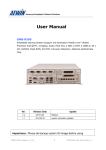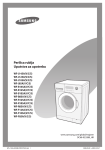Download UM10450 - NXP Semiconductors
Transcript
UM10450 TEA1713 demo board for 90 W notebook adapter Rev. 1 — 11 April 2011 User manual Document information Info Content Keywords TEA1713T, 90 W, notebook adapter, LLC, resonant, half-bridge, PFC, controller, converter, burst mode, power supply, demo board. Abstract The TEA1713T includes a Power Factor Correction (PFC) controller as well as a controller for a Half-Bridge resonant Converter (HBC). This user manual describes a 90 W resonant switching mode power supply for a typical notebook adapter design based on the TEA1713T. The board provides an output of 19.5 V/4.65 A. It operates in normal mode for medium and high power levels and in burst mode for low power levels. Burst mode operation provides a reduction of power losses to increase performance. The efficiency at high power is well above 90 % and the no load power consumption is well below 500 mW. UM10450 NXP Semiconductors TEA1713 demo board for 90 W notebook adapter Revision history Rev Date Description v.1 20110411 first release UM10450 User manual All information provided in this document is subject to legal disclaimers. Rev. 1 — 11 April 2011 © NXP B.V. 2011. All rights reserved. 2 of 38 UM10450 NXP Semiconductors TEA1713 demo board for 90 W notebook adapter 1. Introduction 1.1 Scope of this document This document describes the 90 W notebook adapter demo board using the TEA1713T. A functional description is provided, supported by a set of measurements to show the notebook adapter characteristics. WARNING Lethal voltage and fire ignition hazard The non-insulated high voltages that are present when operating this product, constitute a risk of electric shock, personal injury, death and/or ignition of fire. This product is intended for evaluation purposes only. It shall be operated in a designated test area by personnel qualified according to local requirements and labor laws to work with non-insulated mains voltages and high-voltage circuits. This product shall never be operated unattended. 1.2 TEA1713T The TEA1713T integrates a controller for PFC and a controller for a HBC. It provides the drive function for the discrete MOSFET of the up-converter and for the two discrete power MOSFETs in a resonant half-bridge configuration. The resonant controller part is a high voltage controller for a Zero Voltage Switching (ZVS) LLC resonant converter. It includes a high voltage level shift circuit and several protection features such as OverCurrent Protection (OCP), Open-Loop Protection (OLP), Capacitive Mode Protection (CMP) and a general purpose latched protection input. In addition to the resonant controller, the TEA1713T contains a PFC controller. The efficient operation of the PFC is obtained by functions such as quasi-resonant operation at high power levels and quasi-resonant operation with valley skipping at lower power levels. OCP, OverVoltage Protection (OVP) and demagnetization sensing, ensures safe operation in all conditions. The proprietary high voltage BCD power logic process makes direct start-up from the rectified universal mains voltage in an efficient way possible. A second low voltage Silicon-On-Insulator (SOI) IC is used for accurate, hi-speed protection functions and control. The combination of PFC and a resonant controller in one IC makes the TEA1713T very suitable for notebook adapters. UM10450 User manual All information provided in this document is subject to legal disclaimers. Rev. 1 — 11 April 2011 © NXP B.V. 2011. All rights reserved. 3 of 38 UM10450 NXP Semiconductors TEA1713 demo board for 90 W notebook adapter COMPPFC 1 24 SNSBOOST SNSMAINS 2 23 RCPROT SNSAUXPFC 3 22 SSHBC/EN SNSCURPFC 4 21 SNSFB SNSOUT 5 20 RFMAX SUPIC 6 GATEPFC 7 PGND 8 17 SNSCURHBC SUPREG 9 16 n.c. GATELS 10 15 HB TEA1713T 19 CFMIN 18 SGND 14 SUPHS n.c. 11 13 GATEHS SUPHV 12 014aaa826 Fig 1. Pin configuration TEA1713T 1.3 Setup of the 90 W notebook adapter 019aab663 Fig 2. TEA1713T demo board 90 W notebook adapter The board can operate at a mains input voltage of between 90 V and 264 V (universal mains). The demo board contains two sub-circuits: • A PFC of BCM-type • A HBC of resonant LLC-type Both converters are controlled by the TEA1713T. At low power levels, the converters operate in burst mode to reduce power losses. The purpose of the demo board is to demonstrate the operation of the TEA1713T in a single output supply including burst mode operation. The performance is according today’s general standards and can be used as a starting point for further development. UM10450 User manual All information provided in this document is subject to legal disclaimers. Rev. 1 — 11 April 2011 © NXP B.V. 2011. All rights reserved. 4 of 38 UM10450 NXP Semiconductors TEA1713 demo board for 90 W notebook adapter 1.4 Input and output properties Table 1. Input data Symbol Description Conditions Specification Unit Vi input voltage AC 90 to 264 V (RMS) fi input frequency - 47 to 60 Hz Pi(no load) no load input power 230 V, 50 Hz < 500 mW Table 2. Output data Symbol Description Conditions Specification Unit Vo output voltage - 19.5 V Vo(ripple)(p-p) peak-to-peak ripple voltage 20 MHz bandwidth < 150 mV Io output current continuous 0 to 4.65 A 2. Measurements 2.1 Test facilities • • • • Oscilloscope: Yokogawa DL1640L AC power source: Agilent 6812B Electronic load: Agilent 6063B Digital power meter: Yokogawa WT210 2.2 Start-up behavior The rise time of the output voltage (measured from 10 % to 90 % point of the nominal output) is between 3 ms to 15 ms, depending on the output current load. UM10450 User manual All information provided in this document is subject to legal disclaimers. Rev. 1 — 11 April 2011 © NXP B.V. 2011. All rights reserved. 5 of 38 UM10450 NXP Semiconductors TEA1713 demo board for 90 W notebook adapter (1) (2) (3) (4) 019aab664 (1) PFC (Yellow) (2) HBC (Green) (3) VO (Purple) (4) IO (Blue) Fig 3. UM10450 User manual Start-up behavior at Vmains = 230 V and no load All information provided in this document is subject to legal disclaimers. Rev. 1 — 11 April 2011 © NXP B.V. 2011. All rights reserved. 6 of 38 UM10450 NXP Semiconductors TEA1713 demo board for 90 W notebook adapter (1) (2) (3) (4) 019aab665 (1) PFC (Yellow) (2) HBC (Green) (3) VO (Purple) (4) IO (Blue) Fig 4. Start-up behavior at Vmains = 100 V and full load 2.3 Protection levels on SNSCURHBC and SNSOUT during start-up During start-up the voltage at pin RCPROT (protection timer) always rises. SNSCURHBC detects the initial high primary current and SNSOUT starts at a low voltage. After the first switching cycles the levels become normal for operation and the charging of RCPROT ends. The voltage level on RCPROT now decreases to zero again by the external discharge resistor that is part of the RCPROT system. During normal start-up the initial charging of RCPROT must not trigger a protection (4 V level). UM10450 User manual All information provided in this document is subject to legal disclaimers. Rev. 1 — 11 April 2011 © NXP B.V. 2011. All rights reserved. 7 of 38 UM10450 NXP Semiconductors TEA1713 demo board for 90 W notebook adapter (1) (2) (3) (4) 019aab666 (1) VSNSCURHBC (Blue) (2) VO (Yellow) (3) VSNSOUT (Green) (4) VRCPROT (Purple) Fig 5. UM10450 User manual SNSCURHBC and/or SNSOUT initially charges the protection timer. Start-up at Vmains = 230 V and no load (0 A) All information provided in this document is subject to legal disclaimers. Rev. 1 — 11 April 2011 © NXP B.V. 2011. All rights reserved. 8 of 38 UM10450 NXP Semiconductors TEA1713 demo board for 90 W notebook adapter (1) (2) (3) (4) 019aab667 (1) VSNSCURHBC (Blue) (2) VO (Yellow) (3) VSNSOUT (Green) (4) VRCPROT (Purple) Fig 6. SNSCURHBC and/or SNSOUT initially charges the protection timer. Start-up at Vmains = 100 V and full load (4.65 A) 2.4 Efficiency 2.4.1 Efficiency characteristics Efficiency measurements were made measuring the output voltage on the board (not taking into account the losses in an output connection cable). Table 3. Efficiency results Conditions Energy star 2.0 Efficiency (%) efficiency requirement (%) Average 25 % load 50 % load 75 % load 100 % load 100 V, 60 Hz > 87 90.0 87.5 90.4 91.1 91.1 230 V, 50 Hz > 87 91.2 88.1 91.5 92.6 92.5 UM10450 User manual All information provided in this document is subject to legal disclaimers. Rev. 1 — 11 April 2011 © NXP B.V. 2011. All rights reserved. 9 of 38 UM10450 NXP Semiconductors TEA1713 demo board for 90 W notebook adapter 019aab668 100 (1) efficiency (%) 80 (2) 60 40 20 0 0 20 40 60 80 100 Po (W) (1) Input of 230 V (2) Input 100 V Fig 7. Efficiency at an input voltage of 100 V and 230 V 2.4.2 Power Factor Correction (PFC) Table 4. Power Factor correction (PFC) Condition Energy Star 2.0 requirement Output power (W) Power factor 90 V, 60 Hz - 90 0.99 100 V, 60 Hz - 90 0.99 115 V, 60 Hz ≥ 0.9 90 0.98 230 V, 50 Hz - 90 0.91 264 V, 50 Hz - 90 0.89 2.4.3 No load power consumption Table 5. Output voltage and power consumption at no load Condition Energy Star 2.0 requirement (mW) Output voltage (V) No load power consumption (mW) 90 V, 60 Hz ≤ 500 mW 19.5 340 100 V, 60 Hz ≤ 500 mW 19.5 340 115 V, 60 Hz ≤ 500 mW 19.5 340 230 V, 50 Hz ≤ 500 mW 19.5 380 264 V, 50 Hz ≤ 500 mW 19.5 385 2.5 Behavior in burst mode operation In order to reach the no load power consumption requirements (seeSection 2.4.3), burst mode operation is implemented to improve the performance at low output load. For the demo board burst mode is active below approximately 5 W output power. UM10450 User manual All information provided in this document is subject to legal disclaimers. Rev. 1 — 11 April 2011 © NXP B.V. 2011. All rights reserved. 10 of 38 UM10450 NXP Semiconductors TEA1713 demo board for 90 W notebook adapter 019aab669 10 Pin - Pout (W) 8 6 (2) (3) 4 2 (1) 0 0 20 40 60 80 100 Po (W) (1) Burst mode operation (2) Vmains = 100 V (3) Vmains = 230 V Fig 8. Reduction of power losses as a function of output power (1) (2) (3) 019aab670 (1) VSNSFB (Blue) (2) VO (Purple) (3) HBC (Green) Fig 9. UM10450 User manual Burst mode operation at Vmains = 230 V and no load All information provided in this document is subject to legal disclaimers. Rev. 1 — 11 April 2011 © NXP B.V. 2011. All rights reserved. 11 of 38 UM10450 NXP Semiconductors TEA1713 demo board for 90 W notebook adapter (1) (2) (3) 019aab671 (1) PFC (Yellow) (2) HBC (Green) (3) VSNSOUT (Blue) Fig 10. Switch on/off PFC and HBC by VSNSOUT in burst mode operation The interruptive character of burst mode can lead to the generation of unwanted audible noise. As the supply in burst mode only operates at low power levels, audible noise levels are low. 2.6 Transient response Normal load transients lead to a ripple on the output voltage of < 550 mV. UM10450 User manual All information provided in this document is subject to legal disclaimers. Rev. 1 — 11 April 2011 © NXP B.V. 2011. All rights reserved. 12 of 38 UM10450 NXP Semiconductors TEA1713 demo board for 90 W notebook adapter (1) (2) 019aab672 (1) VO (Purple) (2) IO (Blue) Fig 11. Load-step behavior. Typical load-step from zero to full load 2.7 Output ripple voltage and noise Ripple and noise are measured at full output load, buffered with a 10 μF capacitor in parallel with a high-frequency 0.1 μF capacitor. The varying input voltage of the resonant converter causes a frequency component in the output ripple voltage that is related to the mains voltage frequency: 50 Hz or 60 Hz. The switching frequency of the resonant converter causes the other component in the output ripple voltage. Table 6. UM10450 User manual Ripple and noise test results Mains voltage Mains frequency Output power Ripple frequency Voltage ripple 90 V to 264 V 50 Hz or 60 Hz 90 W 50 Hz or 60 Hz 23 mV (p-p) 90 V to 264 V 50 Hz or 60 Hz 90 W 75 kHz 125 mV (p-p) All information provided in this document is subject to legal disclaimers. Rev. 1 — 11 April 2011 © NXP B.V. 2011. All rights reserved. 13 of 38 UM10450 NXP Semiconductors TEA1713 demo board for 90 W notebook adapter (1) (2) (3) 019aab674 (1) VO (Yellow) (2) VO (Purple) (3) IO (Blue) Fig 12. Output voltage ripple at full load (2 ms/div scale) UM10450 User manual All information provided in this document is subject to legal disclaimers. Rev. 1 — 11 April 2011 © NXP B.V. 2011. All rights reserved. 14 of 38 UM10450 NXP Semiconductors TEA1713 demo board for 90 W notebook adapter (1) (2) (3) 019aab675 (1) VO (Yellow) (2) VO (Purple) (3) IO (Blue) Fig 13. Output voltage ripple at full load (20 μs/div scale) 2.8 OverPower Protection (OPP) Tested with a higher current (dynamic overload) on the output voltage, the OPP is activated when the current exceeds 6 A (117 W). This corresponds to a load condition that is 30 % higher than the rated power for continuous use. The OPP is detected by the SNSCURHBC function of the TEA1713T that monitors the primary resonant current. When the voltage on the SNSCURHBC pin exceeds 0.5 V (or −0.5 V) the protection timer is started. UM10450 User manual All information provided in this document is subject to legal disclaimers. Rev. 1 — 11 April 2011 © NXP B.V. 2011. All rights reserved. 15 of 38 UM10450 NXP Semiconductors TEA1713 demo board for 90 W notebook adapter (1) (2) (3) 019aab676 (1) VSNSCURHBC (Purple) (2) IO (Blue) (3) VRCPROT (Yellow) Fig 14. Dynamic current load leading to OPP 2.9 Hold-up time The output is set to full load and the mains supply voltage of 100 V is disconnected. The time that passes before the output voltage falls below 90 % of its initial value is then measured. The hold-up time is 28 ms. UM10450 User manual All information provided in this document is subject to legal disclaimers. Rev. 1 — 11 April 2011 © NXP B.V. 2011. All rights reserved. 16 of 38 UM10450 NXP Semiconductors TEA1713 demo board for 90 W notebook adapter (1) (2) (3) 019aab677 (1) VO (Purple) (2) IO (Blue) (3) Vmains (Green and Yellow) Fig 15. Hold-up time 2.10 Short-circuit protection A short circuit on the output of the resonant converter causes the primary current to increase. This is detected by the SNSCURHBC function leading to running on maximum frequency until the protection timer RCPROT reaches its protection level (4 V). The RCPROT function performs its restart timer function and restarts again when the voltage has dropped to 0.5 V. When the short-circuit is removed, the converter starts up and operates as normal. This is the main protection mechanism. Under certain conditions other protections can be activated during the output short circuit test. UM10450 User manual All information provided in this document is subject to legal disclaimers. Rev. 1 — 11 April 2011 © NXP B.V. 2011. All rights reserved. 17 of 38 UM10450 NXP Semiconductors TEA1713 demo board for 90 W notebook adapter (1) (2) (3) (4) 019aab678 (1) VSNSCURHBC (Purple) (2) VRCPROT (Yellow) (3) IO (Blue) (4) VO (Green) Fig 16. Protection and restart at output short-circuit UM10450 User manual All information provided in this document is subject to legal disclaimers. Rev. 1 — 11 April 2011 © NXP B.V. 2011. All rights reserved. 18 of 38 UM10450 NXP Semiconductors TEA1713 demo board for 90 W notebook adapter 2.11 Resonant current measurements (1) (2) (3) (4) 019aab679 (1) Iresonant_primary (Blue) (2) VCFMIN (Yellow) (3) VHB Green) (4) VGATE_MOSFET_LS (Purple) Fig 17. Resonant current (full load IO = 4.65 A) UM10450 User manual All information provided in this document is subject to legal disclaimers. Rev. 1 — 11 April 2011 © NXP B.V. 2011. All rights reserved. 19 of 38 UM10450 NXP Semiconductors TEA1713 demo board for 90 W notebook adapter (1) (2) (3) (4) 019aab680 (1) Iresonant_primary (Blue) (2) VCFMIN (Yellow) (3) VHB (Green) (4) VGATE_MOSFET_LS (Purple) Fig 18. Resonant current (low load IO = 0.5 A) UM10450 User manual All information provided in this document is subject to legal disclaimers. Rev. 1 — 11 April 2011 © NXP B.V. 2011. All rights reserved. 20 of 38 UM10450 NXP Semiconductors TEA1713 demo board for 90 W notebook adapter (1) (2) (3) (4) 019aab681 (1) Iresonant_primary (Blue) (2) VCFMIN (Yellow) (3) VHB (Green) (4) VGATE_MOSFET_LS (Purple) Fig 19. Resonant current (no load IO = 0 A) UM10450 User manual All information provided in this document is subject to legal disclaimers. Rev. 1 — 11 April 2011 © NXP B.V. 2011. All rights reserved. 21 of 38 UM10450 NXP Semiconductors TEA1713 demo board for 90 W notebook adapter 2.12 Temperature measurement Sp1 57.5 Sp8 58.5 Sp7 55.6 Sp6 57.4 Sp2 66.3 Sp10 59.7 Sp3 63.9 Sp9 54.8 Sp4 67.1 Sp5 68.3 019aab682 Fig 20. Temperature overview at full load and mains supply of 115 V 2.13 EMI performance Conditions: • • • • • • UM10450 User manual Type: Conducted EMC measurement Frequency range: 150 kHz to 30 MHz Output power: Full load condition Supply voltage: 115 V and 230 V Measuring time: 50 ms Secondary ground connected to mains earth ground All information provided in this document is subject to legal disclaimers. Rev. 1 — 11 April 2011 © NXP B.V. 2011. All rights reserved. 22 of 38 xxxx xxxxxxxxxxxxxxxxxxxxxxxxxxxxxx x xxxxxxxxxxxxxx xxxxxxxxxx xxx xxxxxx xxxxxxxxxxxxxxxxxxxxxxx xxxxxxxxxxxxxxxxxxxxxx xxxxx xxxxxx xx xxxxxxxxxxxxxxxxxxxxxxxxxxxxx xxxxxxxxxxxxxxxxxxxxxx xxxxxxxxxxx xxxxxxx xxxxxxxxxxxxxxxxxxx xxxxxxxxxxxxxxxx xxxxxxxxxxxxxx xxxxxx xx xxxxxxxxxxxxxxxxxxxxxxxxxxxxxxxx xxxxxxxxxxxxxxxxxxxxxxxx xxxxxxx xxxxxxxxxxxxxxxxxxxxxxxxxxxxxxxxxxxxxxxxxxxxxx xxxxxxxxxxx xxxxx x x L101 G VF101 2K471 1 mH 1A C101 330 nF 275 V R101 2 MΩ R102 2 MΩ MUR460 R103 5.1 kΩ 12.8 mH R134 R108 3.6 kΩ R133 47 kΩ C120 2 μF R113 0Ω U101 (PART) SNSAUXPFC 560 kΩ SNSMAINSPFC 3 12 2 7 C121 2 μF GATEPFC R132 COMPPFC 33 kΩ 8 1 C107 100 pF R104 10 Ω D108 TEA1713 PGND Q100 2SK3568 SUPHV (PART) C122 470 nF E101 68 μF 450 V VBUS C106 470 nF N CN101 VBUS 220 μH C104 470 nF L102 D102 40TS:2Ts L104 L103 BD101 GBU806 R105 100 kΩ R110 4.7 MΩ BAS316 4 24 SNSCURPFC R107 R106 1 kΩ 12 kΩ C108 SNSBOOST R109 4.7 MΩ R112 0.1 Ω 1W R111A 3.6 kΩ 47 nF C123 150 nF C109 4.7 nF R111B 56 kΩ 019aab798 UM10450 23 of 38 © NXP B.V. 2011. All rights reserved. Fig 21. Circuit diagram TEA1713T 90 W demo board (PFC part) TEA1713 demo board for 90 W notebook adapter Rev. 1 — 11 April 2011 All information provided in this document is subject to legal disclaimers. 3.15 A 250 V NXP Semiconductors 3. Circuit diagram UM10450 User manual F101 L xxxx xxxxxxxxxxxxxxxxxxxxxxxxxxxxxx x xxxxxxxxxxxxxx xxxxxxxxxx xxx xxxxxx xxxxxxxxxxxxxxxxxxxxxxx xxxxxxxxxxxxxxxxxxxxxx xxxxx xxxxxx xx xxxxxxxxxxxxxxxxxxxxxxxxxxxxx xxxxxxxxxxxxxxxxxxxxxx xxxxxxxxxxx xxxxxxx xxxxxxxxxxxxxxxxxxx xxxxxxxxxxxxxxxx xxxxxxxxxxxxxx xxxxxx xx xxxxxxxxxxxxxxxxxxxxxxxxxxxxxxxx xxxxxxxxxxxxxxxxxxxxxxxx xxxxxxx xxxxxxxxxxxxxxxxxxxxxxxxxxxxxxxxxxxxxxxxxxxxxx xxxxxxxxxxx xxxxx x x NXP Semiconductors UM10450 User manual D103 Q102 SPA04N60C3 BAS316 R114 R115 10 Ω 22 Ω VBUS C110 47 pF U101 GATEHS D107 MURS160 C117 330 nF 14 11 15 10 SUPHV SNSCURHB 16 9 17 8 BAS316 GATELS R118 R116 10 Ω 22 Ω 18 7 C111 47 pF R144 C112 1 nF C132 680 nF PGND E103 4.7 μF SNSCURHB SUPREG GATEPFC C124 R131 RFMAX 19 6 20 5 SUPIC C118 680 nF SNSOUT 18 kΩ SNSFB C105 C125 220 nF C126 2.2 μF RCPROT R130 75 kΩ 4 R117 10 Ω E102 220 μF C116 10 nF SNSCURPFC R119 D105 0Ω BAS316 270 kΩ R121 39 kΩ SNSBOOST 3 SUPREG 23 2 24 1 SNSMAINS U102A LM393D 1 Q104 BC847-40 8 2 4 3 COMPPFC R128 R135A 7 R124 33 kΩ R125 56 kΩ n.m. n.m. R135B n.m. C119 10 nF C129 6.8 nF R126 2.2 kΩ R138 470 Ω R125A 3 kΩ 100 kΩ U102B LM393D soldering output cable D110 MBR2060 SNSAUXPFC R122 33 kΩ 19V_4.72A E107 470 μF C115 BAS316 390 nF C130 22 n.m. E106 470 μF D106 R120 n.m. R143 C114 2.2 nF n.m. SSHBC/EN EN 21 D109 MBR2060 D110 BAV99 SUPIC 330 pF C131 C113 22 nF n.m. TEA1713 CFMIN Lp = 1.4 mH Ls = 196 μH 50 : 6 : 5 : 5 (Prim:Aux:Sec1:Sec2) SUPREG 1 kΩ SGND T101 Q103 SPA04N60C3 n.c. 6 C103 1 nF U106 SFH615A-2 CTR 63 % - 128 % SUPREG R146 330 Ω R141 C134 R139 15 kΩ 1% 2.7 kΩ 47 nF C133 5 2.2 nF R127 C128 0Ω 2.2 nF U105 TL431 R140A 0Ω 019aab683 Fig 22. Circuit diagram TEA1713T 90 W demo board (HBC part) UM10450 24 of 38 © NXP B.V. 2011. All rights reserved. R140B 2.2 kΩ 1% TEA1713 demo board for 90 W notebook adapter Rev. 1 — 11 April 2011 All information provided in this document is subject to legal disclaimers. HB n.c. R123 12 D104 SUPHS SUPREG SNSCURHB 13 xxxx xxxxxxxxxxxxxxxxxxxxxxxxxxxxxx x xxxxxxxxxxxxxx xxxxxxxxxx xxx xxxxxx xxxxxxxxxxxxxxxxxxxxxxx xxxxxxxxxxxxxxxxxxxxxx xxxxx xxxxxx xx xxxxxxxxxxxxxxxxxxxxxxxxxxxxx xxxxxxxxxxxxxxxxxxxxxx xxxxxxxxxxx xxxxxxx xxxxxxxxxxxxxxxxxxx xxxxxxxxxxxxxxxx xxxxxxxxxxxxxx xxxxxx xx xxxxxxxxxxxxxxxxxxxxxxxxxxxxxxxx xxxxxxxxxxxxxxxxxxxxxxxx xxxxxxx xxxxxxxxxxxxxxxxxxxxxxxxxxxxxxxxxxxxxxxxxxxxxx xxxxxxxxxxx xxxxx x x NXP Semiconductors UM10450 User manual 3.15 A 250 V L101 G VF101 2K471 1 mH 1A C101 330 nF 275 V R101 2 MΩ R102 2 MΩ MUR460 COIL STATE SENSING C106 470 nF R103 5.1 kΩ 12.8 mH R134 PFC FILTER MAINS INPUT FILERS VBUS R113 0Ω U101 (PART) SNSAUXPFC N CN101 VBUS 220 μH C104 470 nF L102 D102 40TS:2Ts L104 L103 BD101 GBU806 3 12 3.6 kΩ R108 SNSMAINSPFC 560 kΩ R133 47 kΩ C120 2 μF C121 2 μF TEA1713 (PART) SENSING MAINS VOLTAGE PGND PRESET OF GAIN COMPENSATION FOR MAINS VOLTAGE R132 COMPPFC 33 kΩ C122 470 nF 7 2 C123 150 nF 8 4 1 24 SUPHV HIGH VOLTAGE STARTUP GATEPFC R104 OPTIONAL CIRCUIT TO LIMIT GATE DRIVE CURRENT 10 Ω D108 SNSCURPFC SNSBOOST E101 68 μF 450 V BUS VOLTAGE SENSING Q100 2SK3568 C107 100 pF R105 100 kΩ R110 4.7 MΩ BAS316 R107 R106 1 kΩ 12 kΩ C108 R109 4.7 MΩ R112 0.1 Ω 1W R111A 3.6 kΩ 47 nF CURRENT SENSING AND SOFT-START PRESET C109 4.7 nF R111B 56 kΩ 019aab799 UM10450 25 of 38 © NXP B.V. 2011. All rights reserved. Fig 23. Circuit diagram TEA1713T 90 W demo board with comments (PFC part) TEA1713 demo board for 90 W notebook adapter Rev. 1 — 11 April 2011 All information provided in this document is subject to legal disclaimers. F101 L xxxx xxxxxxxxxxxxxxxxxxxxxxxxxxxxxx x xxxxxxxxxxxxxx xxxxxxxxxx xxx xxxxxx xxxxxxxxxxxxxxxxxxxxxxx xxxxxxxxxxxxxxxxxxxxxx xxxxx xxxxxx xx xxxxxxxxxxxxxxxxxxxxxxxxxxxxx xxxxxxxxxxxxxxxxxxxxxx xxxxxxxxxxx xxxxxxx xxxxxxxxxxxxxxxxxxx xxxxxxxxxxxxxxxx xxxxxxxxxxxxxx xxxxxx xx xxxxxxxxxxxxxxxxxxxxxxxxxxxxxxxx xxxxxxxxxxxxxxxxxxxxxxxx xxxxxxx xxxxxxxxxxxxxxxxxxxxxxxxxxxxxxxxxxxxxxxxxxxxxx xxxxxxxxxxx xxxxx x x NXP Semiconductors UM10450 User manual D103 Q102 SPA04N60C3 BAS316 R114 R115 10 Ω 22 Ω VBUS OPTIONAL C110 CAPACITORS 47 pF TO OPTIMIZE OPTIONAL CIRCUIT TO LIMIT GATE DRIVE CURRENT U101 GATEHS D107 MURS160 C117 330 nF 14 11 OPTIONAL CIRCUIT SUPHV TO LIMIT GATE DRIVE CURRENT HB n.c. SNSCURHB 15 10 16 9 17 8 BAS316 GATELS R118 R116 10 Ω 22 Ω OPTIONAL COMPENSATION OF OCR+OCP FOR INPUT VOLTAGE VARIATIONS SGND E103 4.7 μF C132 680 nF 6 RFMAX 20 5 21 4 SNSOUT C118 680 nF C105 n.m. SSHBC/EN C125 220 nF C126 2.2 μF RCPROT R130 75 kΩ SNSBOOST 22 3 23 2 24 1 n.m. SNSAUXPFC E102 220 μF TIMING PFC BURST R119 D105 0Ω BAS316 270 kΩ R121 39 kΩ Q104 BC847-40 E106 470 μF 8 2 4 3 COMPPFC R128 BURST MODE COMPARATOR CIRCUIT 7 soldering output cable R124 33 kΩ R125 56 kΩ R135A C130 n.m. n.m. R135B OPTIONAL CIRCUIT TO OPTIMIZE DIODE SWITCHING n.m. C119 10 nF C129 6.8 nF R126 2.2 kΩ OUTPUT VOLTAGE SENSING AND REGULATION WITH A TYPICAL TL431 AND OPTOCOUPLER CONSTRUCTION R138 470 Ω R125A 3 kΩ 100 kΩ U102B LM393D 19V_4.72A E107 470 μF D110 MBR2060 MEASURING OUTPUT VOLTAGE ON OVP AND UVP 1 n.m. C115 BAS316 390 nF SUPREG U102A LM393D OPTIONAL CIRCUIT TO OPTIMIZE DIODE SWITCHING C114 2.2 nF D106 R120 R122 33 kΩ SNSMAINS R117 10 Ω DISABLING OCP FUNCTION (OCR REMAINS) C116 10 nF SNSCURPFC n.m. R143 D109 MBR2060 D110 BAV99 SUPIC 18 kΩ EN PRESET OF RC-TIMER GATEPFC C131 C113 22 nF SNSCURHB SUPREG SUPIC 19 R144 C112 1 nF PGND 330 pF SNSFB SOFTSTART TIME PRESET 7 C111 47 pF Lp = 1.4 mH Ls = 196 μH 50 : 6 : 5 : 5 (Prim:Aux:Sec1:Sec2) PRIMARY CURRENT SENSING: OCR/OCP SUPREG TEA1713 CFMIN C124 R131 18 T101 Q103 SPA04N60C3 n.c. 1 kΩ OSCILLATOR AND FREQUENCY RANGE PRESET OPTIONAL CAPACITORS TO OPTIMIZE TRANSITIONS 6 C103 1 nF U106 SFH615A-2 CTR 63 % - 128 % SUPREG R146 330 Ω R141 C134 R139 15 kΩ 1% 2.7 kΩ 47 nF C133 5 2.2 nF R127 C128 0Ω 2.2 nF U105 TL431 R140A 0Ω 019aab684 Fig 24. Circuit diagram TEA1713T 90 W demo board with comments (HBC part) UM10450 26 of 38 © NXP B.V. 2011. All rights reserved. R140B 2.2 kΩ 1% TEA1713 demo board for 90 W notebook adapter Rev. 1 — 11 April 2011 All information provided in this document is subject to legal disclaimers. BOOTSTRAP FUNCTION FOR HIGH SIDE DRIVER SUPPLY R123 12 D104 SUPHS SUPREG SNSCURHB 13 TRANSITIONS xxxx xxxxxxxxxxxxxxxxxxxxxxxxxxxxxx x xxxxxxxxxxxxxx xxxxxxxxxx xxx xxxxxx xxxxxxxxxxxxxxxxxxxxxxx xxxxxxxxxxxxxxxxxxxxxx xxxxx xxxxxx xx xxxxxxxxxxxxxxxxxxxxxxxxxxxxx xxxxxxxxxxxxxxxxxxxxxx xxxxxxxxxxx xxxxxxx xxxxxxxxxxxxxxxxxxx xxxxxxxxxxxxxxxx xxxxxxxxxxxxxx xxxxxx xx xxxxxxxxxxxxxxxxxxxxxxxxxxxxxxxx xxxxxxxxxxxxxxxxxxxxxxxx xxxxxxx xxxxxxxxxxxxxxxxxxxxxxxxxxxxxxxxxxxxxxxxxxxxxx xxxxxxxxxxx xxxxx x x NXP Semiconductors 4. PCB layout UM10450 User manual 127.4318 mm 019aab685 UM10450 27 of 38 © NXP B.V. 2011. All rights reserved. Fig 25. Demo board PCB layout (copper tracks and areas) TEA1713 demo board for 90 W notebook adapter Rev. 1 — 11 April 2011 All information provided in this document is subject to legal disclaimers. 58.9534 mm UM10450 NXP Semiconductors TEA1713 demo board for 90 W notebook adapter 5. Bill Of Materials (BOM) Table 7 provides detailed component information for the TEA1713T demo board for 90 W notebook adapter. Table 7. UM10450 User manual BOM for the TEA1713T demo board Reference Component C103 Tolerance Package Remarks 102/50 V 805 Ceramic cap C105 not mounted 805 Ceramic cap C107 101/1 KV 1206 Ceramic cap C108 473/50 V 805 Ceramic cap C109 472/50 V 805 Ceramic cap C110 47P/1 KV 1206 Ceramic cap C111 47P/1 KV 1206 Ceramic cap C112 102/1 KV 1206 Ceramic cap C114 222/16 V 805 Ceramic cap C115 394/50 V 805 Ceramic cap C116 103/16 V 1206 Ceramic cap C117 334/50 V 805 Ceramic cap C118 684/50 V 805 Ceramic cap C119 103/16 V 805 Ceramic cap C120 205/50 V 805 Ceramic cap C121 205/50 V 805 Ceramic cap C122 474/16 V 805 Ceramic cap C123 154/16 V 805 Ceramic cap C124 331/16 V 805 Ceramic cap C125 224/16 V 805 Ceramic cap C126 225/16 V 805 Ceramic cap C129 682/16 V 805 Ceramic cap C130 not mounted 1206 Ceramic cap C131 not mounted 1206 Ceramic cap C132 684/16 V 1206 Ceramic cap C133 222/16 V 805 Ceramic cap C134 473/16 V 805 Ceramic cap L101 1 mH/1 A L0.2H Common choke L102 12.8 mH L0.4 Common choke CN101 ST-A04-001JT6T4 3.96 × 5 SHINE D102 MUR460 diode 0.7 Onsemi D103 PMLL4148 1206-D NXP Semiconductors D104 PMLL4148 1206-D NXP Semiconductors D105 BAS316 sc-76 NXP Semiconductors All information provided in this document is subject to legal disclaimers. Rev. 1 — 11 April 2011 © NXP B.V. 2011. All rights reserved. 28 of 38 UM10450 NXP Semiconductors TEA1713 demo board for 90 W notebook adapter Table 7. UM10450 User manual BOM for the TEA1713T demo board …continued Reference Component Package Remarks D106 BAS316 Tolerance sc-76 NXP Semiconductors D107 MURS160 SMB Onsemi D108 PMLL4148 1206-D NXP Semiconductors D109A MBR2060 TO-220 Onsemi D109B MBR2060 TO-221 Onsemi D110 BAV99 D101 GBU806 bridge Diode bridge E101 68 μF/450 V EC16/8H E-cap E102 220 μF RB.1/.2 E-cap E103 4.7 μF RB.1/.2 E-cap E106 470 μF/25 V EC5/10H E-cap E107 470 μF/25 V EC5/10H E-cap F101 3.15 A/250 V FUSH_1 Fuse U101 TEA1713T SO-24 NXP Semiconductors U102 LM393D SO-8 ST U105 TL431ALP TO-92A Ti L103 220 μH EM1H Inductor Q100 2SK3568 TO-220H Toshiba Q102 SPA04N60C3 TO-220H Infineon Q103 SPA04N60C3 TO-220H Infineon Q104 BC847-40 SOT-23 NXP Semiconductors U106 SFH615A-2 DIP4 Optocoupler L104 RM8 PFC_PQ2620 PFC choke R101 205 ±5 % 1206 Resistor R102 205 ±5 % 1206 Resistor R103 512 1206 Resistor R104 10R ±5 % 805 Resistor R105 104 ±5 % 1206 Resistor R106 123 ±5 % 805 Resistor R107 102 ±5 % 805 Resistor R108 564 805 Resistor R109 475 1% axial0.4 Resistor R110 475 1% axial0.4 Resistor R111A 362 1% 805 Resistor R111B 563 1% 805 Resistor R112 0.1,1 W ResV Resistor R113 0R 1206 Resistor NXP Semiconductors All information provided in this document is subject to legal disclaimers. Rev. 1 — 11 April 2011 © NXP B.V. 2011. All rights reserved. 29 of 38 UM10450 NXP Semiconductors TEA1713 demo board for 90 W notebook adapter Table 7. UM10450 User manual BOM for the TEA1713T demo board …continued Reference Component Tolerance Package Remarks R114 10 ±5 % 805 Resistor R115 22R ±5 % 805 Resistor R116 22R ±5 % 805 Resistor R117 10R ±5 % 805 Resistor R118 10 axial0.3 Resistor R119 0R 1206 Resistor R120 274 805 Resistor R121 393 805 Resistor R122 333 805 Resistor R123 102 805 Resistor R124 333 805 Resistor R125 513 805 Resistor R125A 302 [1] 805 Resistor R126 222 805 Resistor R127 0 805 Resistor R128 104 805 Resistor R130 753 805 Resistor R131 183 805 Resistor R132 333 805 Resistor R133 473 805 Resistor R134 362 805 Resistor R135A not mounted 1206 Resistor R135B not mounted 1206 Resistor R138 470R 805 Resistor R139 15 805 Resistor R140A 0R 805 Resistor R140B 222 805 Resistor R141 272 805 Resistor R143 not mounted 1206 Resistor R144 not mounted 1206 Resistor R146 330R 805 Resistor C104 0.47 μF/450 V rad0.4 V Thin film cap C106 0.47 μF/450 V rad0.4 V Thin film cap C113 22 nF/1000 V RAD0.6(0.8)-3 Thin film cap P T101 TR2 LP-2920 Transformer C101 334/275 V RAD0.6H X cap C128 222 C10(0.6)-1F Y1 cap VF101 2k471 rad0.4 MOV J1 6.8 mm Jumper J2 9.2 mm Jumper 1% 1% All information provided in this document is subject to legal disclaimers. Rev. 1 — 11 April 2011 © NXP B.V. 2011. All rights reserved. 30 of 38 UM10450 NXP Semiconductors TEA1713 demo board for 90 W notebook adapter Table 7. Reference Component J3 2.9 mm Jumper J4 31 mm Jumper J5 28 mm Jumper J6 31 mm Jumper J7 31 mm Jumper J8 15 mm Jumper J9 17.5 mm Jumper J10 20.9 mm Jumper J11 6.6 mm Jumper J12 13.9 mm Jumper J13 13.2 mm Jumper H1 108 × 23 × 3 H2 90 × 23 × 3 [1] UM10450 User manual BOM for the TEA1713T demo board …continued Tolerance Package Remarks R125A: a different value can be used for fine tuning burst mode. All information provided in this document is subject to legal disclaimers. Rev. 1 — 11 April 2011 © NXP B.V. 2011. All rights reserved. 31 of 38 UM10450 NXP Semiconductors TEA1713 demo board for 90 W notebook adapter 6. Appendix 1 - Resonant transformer data 6.1 Transformer diagram 30.0 MAX 40.0 MAX 22.0 MAX 40±0.5 1 0.8ر0.1 6 12 1 12 7 1 6 MYLAR TAPE 1L 5±0.5 7 12 33±1 6 1 2 11 N2 N3 1 12 3 9 N1 N4 6 10 PIN 12(10) N4: 0.10Ø*100s*1c*5Ts(LITZ) N3: 0.10Ø*100s*1c*5Ts(LITZ) PIN 1 N2: 0.20Ø*1c*6Ts(TEX-E) * PIN 11(9) * PIN 2 17.5Ts Ref 18Ts Ref N1: 0.10Ø*25s*1c*50Ts (LITZ) 14.5Ts Ref MYLAR TAPE 2Ts PIN 6 * PIN 3 BOBBIN PIN 1-6 PIN 7-12 019aab686 Fig 26. Resonant transformer data LP-2920HA63 UM10450 User manual All information provided in this document is subject to legal disclaimers. Rev. 1 — 11 April 2011 © NXP B.V. 2011. All rights reserved. 32 of 38 UM10450 NXP Semiconductors TEA1713 demo board for 90 W notebook adapter 6.2 Transformer electrical specification Table 8. Electrical specification HP: 4284A ZENTECH: 3200B, 502A, F = 100 kHz, V = 1 V, at 25 °C No Start Finish Wire Color Turns Inductance DCR (mΩ) L1 3 6 0.10 ∅ × 25 s × 1 ∅ (LITZ) Y 50 ±0.5 1.4 mH ±10 % 334 max L2 2 L3 11 1 0.20 ∅ × 1 ∅ (TEX-E) Y 6 ±0.5 19.0 μH REF 250 max 12 0.10 ∅ × 100 s × 1 ∅ (LITZ) Y 5 ±0.5 12.0 μH REF 9 max L4 9 10 0.10 ∅ × 100 s × 1 ∅ (LITZ) Y 5 ±0.5 12.0 μH REF 9 max Lk 3 6 0.10 ∅ × 25 s × 1 ∅ (LITZ) Y 50 ±0.5 225 μH ±10 % at secondary short 7. Appendix 2 - PFC coil data 7.1 Transformer schematic diagram S1 9 N1 7 5 N2 1 N1 BOBBIN N2 S2 019aab687 Fig 27. Transformer schematic diagram 7.2 Winding specification Table 9. No Winding specification Pin Wire Turns Winding method Margin tape Insulation Start Finish Primary Secondary Turn Width N1 9 7 0.1 ∅ × 30 40 center - - 1 10 mm N2 5 1 0.22 ∅ × 2 2 center - - 1 10 mm S1 - - 0.05t × 14 mm 1 center - - 1 14 mm (S2) S2 - 1 0.05t × 14 mm 1 center - - 1 14 mm (S1) 7.3 Electrical characteristics Table 10. Electrical characteristic Pins Specification Remarks Inductance 9 to 7 250 μH ±10 % 60 kHz, 1 V Leakage inductance 9 to 7 N/A - 7.4 Core, bobbin and marking Core and bobbin: • Core: RM-10 (Ferroxcube RM/I or equivalent) • Bobbin: RM-10 (12 pin, vertical type) • Ae: 96.6 mm2 UM10450 User manual All information provided in this document is subject to legal disclaimers. Rev. 1 — 11 April 2011 © NXP B.V. 2011. All rights reserved. 33 of 38 UM10450 NXP Semiconductors TEA1713 demo board for 90 W notebook adapter Marking: • PFC-APBADC015 8. Abbreviations Table 11. Abbreviations Acronym Description BCM Boundary conduction Mode CMP Capacitive Mode Protection EMC ElectroMagnetic Compatibility EMI ElectroMagnetic Interference HBC Half-Bridge resonant Converter MOSFET Metal-Oxide Semiconductor Field-Effect Transistor OCP OverCurrent Protection OPP OverPower Protection OVP OverVoltage Protection OLP Open-Loop Protection PCB Printed-Circuit Board PFC Power Factor Correction RMS Root Mean Square SOI Silicon On Insulator ZVS Zero Voltage Switching 9. References UM10450 User manual [1] TEA1713T — data sheet - resonant power supply control IC with PFC [2] AN10881 — application note - resonant power supply control IC with PFC [3] UM10379 — user manual - 250 W LCD-TV demo board [4] Calculation sheet — http://www.nxp.com/technical_support/designportal/llc All information provided in this document is subject to legal disclaimers. Rev. 1 — 11 April 2011 © NXP B.V. 2011. All rights reserved. 34 of 38 UM10450 NXP Semiconductors TEA1713 demo board for 90 W notebook adapter 10. Legal information 10.1 Definitions Draft — The document is a draft version only. The content is still under internal review and subject to formal approval, which may result in modifications or additions. NXP Semiconductors does not give any representations or warranties as to the accuracy or completeness of information included herein and shall have no liability for the consequences of use of such information. Export control — This document as well as the item(s) described herein may be subject to export control regulations. Export might require a prior authorization from national authorities. 10.2 Disclaimers Limited warranty and liability — Information in this document is believed to be accurate and reliable. However, NXP Semiconductors does not give any representations or warranties, expressed or implied, as to the accuracy or completeness of such information and shall have no liability for the consequences of use of such information. In no event shall NXP Semiconductors be liable for any indirect, incidental, punitive, special or consequential damages (including - without limitation - lost profits, lost savings, business interruption, costs related to the removal or replacement of any products or rework charges) whether or not such damages are based on tort (including negligence), warranty, breach of contract or any other legal theory. Notwithstanding any damages that customer might incur for any reason whatsoever, NXP Semiconductors’ aggregate and cumulative liability towards customer for the products described herein shall be limited in accordance with the Terms and conditions of commercial sale of NXP Semiconductors. Right to make changes — NXP Semiconductors reserves the right to make changes to information published in this document, including without limitation specifications and product descriptions, at any time and without notice. This document supersedes and replaces all information supplied prior to the publication hereof. Suitability for use — NXP Semiconductors products are not designed, authorized or warranted to be suitable for use in life support, life-critical or safety-critical systems or equipment, nor in applications where failure or malfunction of an NXP Semiconductors product can reasonably be expected to result in personal injury, death or severe property or environmental damage. NXP Semiconductors accepts no liability for inclusion and/or use of NXP Semiconductors products in such equipment or applications and therefore such inclusion and/or use is at the customer’s own risk. Applications — Applications that are described herein for any of these products are for illustrative purposes only. NXP Semiconductors makes no representation or warranty that such applications will be suitable for the specified use without further testing or modification. Customers are responsible for the design and operation of their applications and products using NXP Semiconductors products, and NXP Semiconductors accepts no liability for any assistance with applications or customer product design. It is customer’s sole responsibility to determine whether the NXP Semiconductors product is suitable and fit for the customer’s applications and products planned, as well as for the planned application and use of customer’s third party customer(s). Customers should provide appropriate design and operating safeguards to minimize the risks associated with their applications and products. UM10450 User manual NXP Semiconductors does not accept any liability related to any default, damage, costs or problem which is based on any weakness or default in the customer’s applications or products, or the application or use by customer’s third party customer(s). Customer is responsible for doing all necessary testing for the customer’s applications and products using NXP Semiconductors products in order to avoid a default of the applications and the products or of the application or use by customer’s third party customer(s). NXP does not accept any liability in this respect. Safety of high-voltage evaluation products — The non-insulated high voltages that are present when operating this product, constitute a risk of electric shock, personal injury, death and/or ignition of fire. This product is intended for evaluation purposes only. It shall be operated in a designated test area by personnel that is qualified according to local requirements and labor laws to work with non-insulated mains voltages and high-voltage circuits. The product does not comply with IEC 60950 based national or regional safety standards. NXP Semiconductors does not accept any liability for damages incurred due to inappropriate use of this product or related to non-insulated high voltages. Any use of this product is at customer’s own risk and liability. The customer shall fully indemnify and hold harmless NXP Semiconductors from any liability, damages and claims resulting from the use of the product. Evaluation products — This product is provided on an “as is” and “with all faults” basis for evaluation purposes only. NXP Semiconductors, its affiliates and their suppliers expressly disclaim all warranties, whether express, implied or statutory, including but not limited to the implied warranties of non-infringement, merchantability and fitness for a particular purpose. The entire risk as to the quality, or arising out of the use or performance, of this product remains with customer. In no event shall NXP Semiconductors, its affiliates or their suppliers be liable to customer for any special, indirect, consequential, punitive or incidental damages (including without limitation damages for loss of business, business interruption, loss of use, loss of data or information, and the like) arising out the use of or inability to use the product, whether or not based on tort (including negligence), strict liability, breach of contract, breach of warranty or any other theory, even if advised of the possibility of such damages. Notwithstanding any damages that customer might incur for any reason whatsoever (including without limitation, all damages referenced above and all direct or general damages), the entire liability of NXP Semiconductors, its affiliates and their suppliers and customer’s exclusive remedy for all of the foregoing shall be limited to actual damages incurred by customer based on reasonable reliance up to the greater of the amount actually paid by customer for the product or five dollars (US$5.00). The foregoing limitations, exclusions and disclaimers shall apply to the maximum extent permitted by applicable law, even if any remedy fails of its essential purpose. 10.3 Trademarks Notice: All referenced brands, product names, service names and trademarks are the property of their respective owners. All information provided in this document is subject to legal disclaimers. Rev. 1 — 11 April 2011 © NXP B.V. 2011. All rights reserved. 35 of 38 UM10450 NXP Semiconductors TEA1713 demo board for 90 W notebook adapter 11. Tables Table 1. Table 2. Table 3. Table 4. Table 5. Input data . . . . . . . . . . . . . . . . . . . . . . . . . . . . . .5 Output data . . . . . . . . . . . . . . . . . . . . . . . . . . . . .5 Efficiency results. . . . . . . . . . . . . . . . . . . . . . . . .9 Power Factor correction (PFC) . . . . . . . . . . . . .10 Output voltage and power consumption at no load . . . . . . . . . . . . . . . . . . . . . . . . . . . . .10 Table 6. Ripple and noise test results . . . . . . . . . . . . . .13 Table 7. BOM for the TEA1713T demo board . . . . . . . .28 Table 8. Electrical specification . . . . . . . . . . . . . . . . . . .33 Table 9. Winding specification . . . . . . . . . . . . . . . . . . . .33 Table 10. Electrical characteristic . . . . . . . . . . . . . . . . . . .33 Table 11. Abbreviations . . . . . . . . . . . . . . . . . . . . . . . . . .34 continued >> UM10450 User manual All information provided in this document is subject to legal disclaimers. Rev. 1 — 11 April 2011 © NXP B.V. 2011. All rights reserved. 36 of 38 UM10450 NXP Semiconductors TEA1713 demo board for 90 W notebook adapter 12. Figures Fig 1. Fig 2. Fig 3. Fig 4. Fig 5. Fig 6. Fig 7. Fig 8. Fig 9. Fig 10. Fig 11. Fig 12. Fig 13. Fig 14. Fig 15. Fig 16. Fig 17. Fig 18. Fig 19. Fig 20. Fig 21. Fig 22. Fig 23. Fig 24. Fig 25. Fig 26. Fig 27. Pin configuration TEA1713T . . . . . . . . . . . . . . . . .4 TEA1713T demo board 90 W notebook adapter . .4 Start-up behavior at Vmains = 230 V and no load . .6 Start-up behavior at Vmains = 100 V and full load . .7 SNSCURHBC and/or SNSOUT initially charges the protection timer. Start-up at Vmains = 230 V and no load (0 A) . . . . . . . . . . . . . . . . . . . . . . . . . .8 SNSCURHBC and/or SNSOUT initially charges the protection timer. Start-up at Vmains = 100 V and full load (4.65 A) . . . . . . . . . . . . . . . . . . . . . . .9 Efficiency at an input voltage of 100 V and 230 V . . . . . . . . . . . . . . . . . . . . . . . . . . . . . .10 Reduction of power losses as a function of output power . . . . . . . . . . . . . . . . . . . . . . . . . . . . 11 Burst mode operation at Vmains = 230 V and no load . . . . . . . . . . . . . . . . . . . . . . . . . . . . . 11 Switch on/off PFC and HBC by VSNSOUT in burst mode operation . . . . . . . . . . . . . . . . . . . . . .12 Load-step behavior. Typical load-step from zero to full load . . . . . . . . . . . . . . . . . . . . . . . . . .13 Output voltage ripple at full load (2 ms/div scale) . . . . . . . . . . . . . . . . . . . . . . . . . .14 Output voltage ripple at full load (20 ms/div scale) . . . . . . . . . . . . . . . . . . . . . . . . .15 Dynamic current load leading to OPP . . . . . . . . .16 Hold-up time . . . . . . . . . . . . . . . . . . . . . . . . . . . .17 Protection and restart at output short-circuit . . . .18 Resonant current (full load IO = 4.65 A) . . . . . . . .19 Resonant current (low load IO = 0.5 A) . . . . . . . .20 Resonant current (no load IO = 0 A) . . . . . . . . . .21 Temperature overview at full load and mains supply of 115 V . . . . . . . . . . . . . . . . . . . . . . . . . .22 Circuit diagram TEA1713T 90 W demo board (PFC part) . . . . . . . . . . . . . . . . . . . . . . . . . . . . . .23 Circuit diagram TEA1713T 90 W demo board (HBC part) . . . . . . . . . . . . . . . . . . . . . . . . . . . . . .24 Circuit diagram TEA1713T 90 W demo board with comments (PFC part) . . . . . . . . . . . . . . . . . .25 Circuit diagram TEA1713T 90 W demo board with comments (HBC part). . . . . . . . . . . . . . . . . .26 Demo board PCB layout (copper tracks and areas). . . . . . . . . . . . . . . . . . . . . . . . . . . . . . . . . .27 Resonant transformer data LP-2920HA63. . . . . .32 Transformer schematic diagram . . . . . . . . . . . . .33 continued >> UM10450 User manual All information provided in this document is subject to legal disclaimers. Rev. 1 — 11 April 2011 © NXP B.V. 2011. All rights reserved. 37 of 38 UM10450 NXP Semiconductors TEA1713 demo board for 90 W notebook adapter 13. Contents 1 1.1 1.2 1.3 1.4 2 2.1 2.2 2.3 2.4 2.4.1 2.4.2 2.4.3 2.5 2.6 2.7 2.8 2.9 2.10 2.11 2.12 2.13 3 4 5 6 6.1 6.2 7 7.1 7.2 7.3 7.4 8 9 10 10.1 10.2 10.3 11 12 13 Introduction . . . . . . . . . . . . . . . . . . . . . . . . . . . . 3 Scope of this document . . . . . . . . . . . . . . . . . . 3 TEA1713T . . . . . . . . . . . . . . . . . . . . . . . . . . . . 3 Setup of the 90 W notebook adapter . . . . . . . . 4 Input and output properties. . . . . . . . . . . . . . . . 5 Measurements . . . . . . . . . . . . . . . . . . . . . . . . . . 5 Test facilities . . . . . . . . . . . . . . . . . . . . . . . . . . . 5 Start-up behavior . . . . . . . . . . . . . . . . . . . . . . . 5 Protection levels on SNSCURHBC and SNSOUT during start-up. . . . . . . . . . . . . . . . . . 7 Efficiency . . . . . . . . . . . . . . . . . . . . . . . . . . . . . 9 Efficiency characteristics . . . . . . . . . . . . . . . . . 9 Power Factor Correction (PFC) . . . . . . . . . . . 10 No load power consumption . . . . . . . . . . . . . . 10 Behavior in burst mode operation. . . . . . . . . . 10 Transient response . . . . . . . . . . . . . . . . . . . . . 12 Output ripple voltage and noise . . . . . . . . . . . 13 OverPower Protection (OPP) . . . . . . . . . . . . . 15 Hold-up time . . . . . . . . . . . . . . . . . . . . . . . . . . 16 Short-circuit protection . . . . . . . . . . . . . . . . . . 17 Resonant current measurements . . . . . . . . . . 19 Temperature measurement . . . . . . . . . . . . . . 22 EMI performance . . . . . . . . . . . . . . . . . . . . . . 22 Circuit diagram . . . . . . . . . . . . . . . . . . . . . . . . 23 PCB layout . . . . . . . . . . . . . . . . . . . . . . . . . . . . 27 Bill Of Materials (BOM) . . . . . . . . . . . . . . . . . . 28 Appendix 1 - Resonant transformer data . . . 32 Transformer diagram . . . . . . . . . . . . . . . . . . . 32 Transformer electrical specification . . . . . . . . 33 Appendix 2 - PFC coil data . . . . . . . . . . . . . . . 33 Transformer schematic diagram . . . . . . . . . . . 33 Winding specification . . . . . . . . . . . . . . . . . . . 33 Electrical characteristics . . . . . . . . . . . . . . . . . 33 Core, bobbin and marking . . . . . . . . . . . . . . . 33 Abbreviations . . . . . . . . . . . . . . . . . . . . . . . . . . 34 References . . . . . . . . . . . . . . . . . . . . . . . . . . . . 34 Legal information. . . . . . . . . . . . . . . . . . . . . . . 35 Definitions . . . . . . . . . . . . . . . . . . . . . . . . . . . . 35 Disclaimers . . . . . . . . . . . . . . . . . . . . . . . . . . . 35 Trademarks. . . . . . . . . . . . . . . . . . . . . . . . . . . 35 Tables . . . . . . . . . . . . . . . . . . . . . . . . . . . . . . . . 36 Figures . . . . . . . . . . . . . . . . . . . . . . . . . . . . . . . 37 Contents . . . . . . . . . . . . . . . . . . . . . . . . . . . . . . 38 Please be aware that important notices concerning this document and the product(s) described herein, have been included in section ‘Legal information’. © NXP B.V. 2011. All rights reserved. For more information, please visit: http://www.nxp.com For sales office addresses, please send an email to: [email protected] Date of release: 11 April 2011 Document identifier: UM10450






































